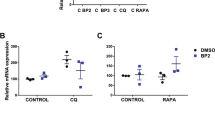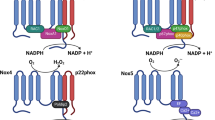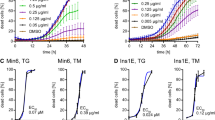Abstract
Perfluorooctanoic acid (PFOA), a widely used chemical substance, causes an increased risk of human type 2 diabetes (T2D), but its underlying mechanism is not well elucidated. The aim of the present study was to investigate whether PFOA regulates the functions of pancreatic β cells, which are specialized for the biosynthesis and secretion of insulin. The treatment of the mouse pancreatic β cell line (MIN6 cells) with PFOA caused a time- and dose-dependent inhibition of cell viability in CCK-8 assays. Annexin V/PI and TUNEL staining results confirmed that exposure to a high PFOA dose (500 μM) promoted apoptosis of β cells, while a low dose (300 μM) had no effects on β cell survival. PFOA treatment, even at a low dose, diminished glucose-stimulated insulin secretion (GSIS) in both primary islet perfusion and MIN6 cell experiments. RNA-sequencing data showed significantly increased expression of endoplasmic reticulum (ER) stress-associated genes, with tribbles homolog 3 (Trib3) ranking first among the altered genes. The activation of ER stress pathways was verified by qRT-PCR assays, and the ATF4/CHOP/TRIB3 pathway contributed to PFOA-induced β cell damage. The inhibition of TRIB3 expression significantly protected MIN6 cells from PFOA-induced GSIS defects and apoptosis by ameliorating ER stress. These findings reveal a link between ER stress and PFOA-induced β cell defects, opening up a new set of questions about the pathogenesis of T2D due to environmental chemicals.
-
PFOA exposure results in pancreatic β cell apoptosis.
-
PFOA treatment diminishes glucose-stimulated insulin secretion in β cells.
-
PFOA activates endoplasmic reticulum stress and increases TRIB3 expression.
-
Inhibition of TRIB3 expression ameliorates PFOA-caused β cell dysfunction and apoptosis.








Similar content being viewed by others
Data availability
The datasets used and/or analyzed during the current study are available from the corresponding author on reasonable request.
References
Andersen CS, Fei C, Gamborg M, Nohr EA, Sorensen TI, Olsen J (2013) Prenatal exposures to perfluorinated chemicals and anthropometry at 7 years of age. Am J Epidemiol 178:921–927
Arbuckle TE, Kubwabo C, Walker M, Davis K, Lalonde K, Kosarac I, Wen SW, Arnold DL (2013) Umbilical cord blood levels of perfluoroalkyl acids and polybrominated flame retardants. Int J Hyg Environ Health 216:184–194
Aylward LL, Hays SM, Kirman CR, Marchitti SA, Kenneke JF, English C, Mattison DR, Becker RA (2014) Relationships of chemical concentrations in maternal and cord blood: a review of available data. Journal of toxicology and environmental health. Part B Crit Rev 17:175–203
Bach CC, Bech BH, Brix N, Nohr EA, Bonde JP, Henriksen TB (2015) Perfluoroalkyl and polyfluoroalkyl substances and human fetal growth: a systematic review. Crit Rev Toxicol 45:53–67
Bach CC, Vested A, Jorgensen KT, Bonde JP, Henriksen TB, Toft G (2016) Perfluoroalkyl and polyfluoroalkyl substances and measures of human fertility: a systematic review. Crit Rev Toxicol 46:735–755
Barry V, Winquist A, Steenland K (2013) Perfluorooctanoic acid (PFOA) exposures and incident cancers among adults living near a chemical plant. Environ Health Perspect 121:1313–1318
Bassler J, Ducatman A, Elliott M, Wen S, Wahlang B, Barnett J, Cave MC (2019) Environmental perfluoroalkyl acid exposures are associated with liver disease characterized by apoptosis and altered serum adipocytokines. Environ Pollut 247:1055–1063
Birukov A, Andersen LB, Andersen MS, Nielsen JH, Nielsen F, Kyhl HB, Jorgensen JS, Grandjean P, Dechend R, Jensen TK (2021) Exposure to perfluoroalkyl substances and blood pressure in pregnancy among 1436 women from the Odense Child Cohort. Environ Int 151:106442
Braun JM, Chen A, Romano ME, Calafat AM, Webster GM, Yolton K, Lanphear BP (2016) Prenatal perfluoroalkyl substance exposure and child adiposity at 8 years of age: the HOME study. Obesity 24:231–237
Calafat AM, Wong LY, Kuklenyik Z, Reidy JA, Needham LL (2007) Polyfluoroalkyl chemicals in the U.S. population: data from the National Health and Nutrition Examination Survey (NHANES) 2003–2004 and comparisons with NHANES 1999–2000. Environ Health Perspect 115:1596–1602
Cheng K, Andrikopoulos S, Gunton JE (2013) First phase insulin secretion and type 2 diabetes. Curr Mol Med 13:126–139
Darrow LA, Stein CR, Steenland K (2013) Serum perfluorooctanoic acid and perfluorooctane sulfonate concentrations in relation to birth outcomes in the Mid-Ohio Valley, 2005–2010. Environ Health Perspect 121:1207–1213
Domazet SL, Grontved A, Timmermann AG, Nielsen F, Jensen TK (2016) Longitudinal associations of exposure to perfluoroalkylated substances in childhood and adolescence and indicators of adiposity and glucose metabolism 6 and 12 years later: the European Youth Heart Study. Diabetes Care 39:1745–1751
Du K, Herzig S, Kulkarni RN, Montminy M (2003) TRB3: a tribbles homolog that inhibits Akt/PKB activation by insulin in liver. Science 300:1574–1577
Eldor R, DeFronzo RA, Abdul-Ghani M (2013) In vivo actions of peroxisome proliferator-activated receptors: glycemic control, insulin sensitivity, and insulin secretion. Diabetes Care 36(Suppl 2):S162–S174
Eriksson U, Mueller JF, Toms LL, Hobson P, Karrman A (2017) Temporal trends of PFSAs, PFCAs and selected precursors in Australian serum from 2002 to 2013. Environ Pollut 220:168–177
Fei C, McLaughlin JK, Tarone RE, Olsen J (2007) Perfluorinated chemicals and fetal growth: a study within the Danish National Birth Cohort. Environ Health Perspect 115:1677–1682
Fromme H, Mosch C, Morovitz M, Alba-Alejandre I, Boehmer S, Kiranoglu M, Faber F, Hannibal I, Genzel-Boroviczeny O, Koletzko B, Volkel W (2010) Pre- and postnatal exposure to perfluorinated compounds (PFCs). Environ Sci Technol 44:7123–7129
Gore AC, Chappell VA, Fenton SE, Flaws JA, Nadal A, Prins GS, Toppari J, Zoeller RT (2015) EDC-2: the Endocrine Society’s Second Scientific Statement on Endocrine-Disrupting Chemicals. Endocr Rev 36:E1–E150
Grosshans J, Wieschaus E (2000) A genetic link between morphogenesis and cell division during formation of the ventral furrow in Drosophila. Cell 101:523–531
Han X, Sun Y, Scott S, Bleich D (2001) Tissue inhibitor of metalloproteinase-1 prevents cytokine-mediated dysfunction and cytotoxicity in pancreatic islets and beta-cells. Diabetes 50:1047–1055
He X, Liu Y, Xu B, Gu L, Tang W (2018) PFOA is associated with diabetes and metabolic alteration in US men: National Health and Nutrition Examination Survey 2003–2012. Sci Total Environ 625:566–574
Hiriart M, Velasco M, Larque C, Diaz-Garcia CM (2014) Metabolic syndrome and ionic channels in pancreatic beta cells. Vitam Horm 95:87–114
Jiao C, Chen W, Tan X, Liang H, Li J, Yun H, He C, Chen J, Ma X, Xie Y, Yang BB (2020) Ganoderma lucidum spore oil induces apoptosis of breast cancer cells in vitro and in vivo by activating caspase-3 and caspase-9. J Ethnopharmacol 247:112256
Karnes C, Winquist A, Steenland K (2014) Incidence of type II diabetes in a cohort with substantial exposure to perfluorooctanoic acid. Environ Res 128:78–83
Kaufman RJ (1999) Stress signaling from the lumen of the endoplasmic reticulum: coordination of gene transcriptional and translational controls. Genes Dev 13:1211–1233
Kaur S, Kumar M, Kaur P, Kaur V, Kaur S (2016) Modulatory effects of Cassia fistula fruits against free radicals and genotoxicity of mutagens. Food Chem Toxicol 98:220–231
Kaur S, Sharma D, Singh AP, Kaur S (2019) Amelioration of hepatic function, oxidative stress, and histopathologic damages by Cassia fistula L. fraction in thioacetamide-induced liver toxicity. Environ Sci Pollut Res Int 26:29930–29945
Kaur S, Kumar A, Thakur S, Kumar K, Sharma R, Sharma A, Singh P, Sharma U, Kumar S, Landi M, Brestic M, Kaur S (2020a) Antioxidant, antiproliferative and apoptosis-inducing efficacy of fractions from Cassia fistula L. leaves. Antioxidants (Basel) 9
Kaur S, Pandit K, Chandel M, Kaur S (2020b) Antiproliferative and apoptogenic effects of Cassia fistula L. n-hexane fraction against human cervical cancer (HeLa) cells. Environ Sci Pollut Res Int 27:32017–32033
Kaur S, Kumar A, Pandit K, Kaur S (2021) Modulation of mutagenicity in Salmonella typhimurium and antioxidant properties and antiproliferative effects of fractions from Cassia fistula L. on human cervical HeLa and breast MCF-7 cancer cells. Environ Sci Pollut Res Int 28:6619–6634
Kristensen SL, Ramlau-Hansen CH, Ernst E, Olsen SF, Bonde JP, Vested A, Halldorsson TI, Becher G, Haug LS, Toft G (2013) Long-term effects of prenatal exposure to perfluoroalkyl substances on female reproduction. Hum Reprod 28:3337–3348
Kurita H, Yoshioka W, Nishimura N, Kubota N, Kadowaki T, Tohyama C (2009) Aryl hydrocarbon receptor-mediated effects of 2,3,7,8-tetrachlorodibenzo-p-dioxin on glucose-stimulated insulin secretion in mice. J Appl Toxicol 29:689–694
Lau C, Anitole K, Hodes C, Lai D, Pfahles-Hutchens A, Seed J (2007) Perfluoroalkyl acids: a review of monitoring and toxicological findings. Toxicol Sci 99:366–394
Li X, Zhao X, Yao Y, Guo M, Li S (2021) New insights into crosstalk between apoptosis and necroptosis co-induced by chlorothalonil and imidacloprid in Ctenopharyngodon idellus kidney cells. Sci Total Environ 780:146591
Liew CW, Bochenski J, Kawamori D, Hu J, Leech CA, Wanic K, Malecki M, Warram JH, Qi L, Krolewski AS, Kulkarni RN (2010) The pseudokinase tribbles homolog 3 interacts with ATF4 to negatively regulate insulin exocytosis in human and mouse beta cells. J Clin Invest 120:2876–2888
Lin CY, Chen PC, Lin YC, Lin LY (2009) Association among serum perfluoroalkyl chemicals, glucose homeostasis, and metabolic syndrome in adolescents and adults. Diabetes Care 32:702–707
Liu HS, Wen LL, Chu PL, Lin CY (2018) Association among total serum isomers of perfluorinated chemicals, glucose homeostasis, lipid profiles, serum protein and metabolic syndrome in adults: NHANES, 2013–2014. Environ Pollut 232:73–79
Ma Y, Yang J, Wan Y, Peng Y, Ding S, Li Y, Xu B, Chen X, Xia W, Ke Y, Xu S (2018) Low-level perfluorooctanoic acid enhances 3 T3–L1 preadipocyte differentiation via altering peroxisome proliferator activated receptor gamma expression and its promoter DNA methylation. J Appl Toxicol 38:398–407
Oberkofler H, Pfeifenberger A, Soyal S, Felder T, Hahne P, Miller K, Krempler F, Patsch W (2010) Aberrant hepatic TRIB3 gene expression in insulin-resistant obese humans. Diabetologia 53:1971–1975
Ohoka N, Yoshii S, Hattori T, Onozaki K, Hayashi H (2005) TRB3, a novel ER stress-inducible gene, is induced via ATF4-CHOP pathway and is involved in cell death. EMBO J 24:1243–1255
Ord T, Ord D, Adler P, Vilo J, Ord T (2015) TRIB3 enhances cell viability during glucose deprivation in HEK293-derived cells by upregulating IGFBP2, a novel nutrient deficiency survival factor. Biochim Biophys Acta 1853:2492–2505
Poet TS, Schlosser PM, Rodriguez CE, Parod RJ, Rodwell DE, Kirman CR (2016) Using physiologically based pharmacokinetic modeling and benchmark dose methods to derive an occupational exposure limit for N-methylpyrrolidone. Regul Toxicol Pharmacol 76:102–112
Prudente S, Sesti G, Pandolfi A, Andreozzi F, Consoli A, Trischitta V (2012) The mammalian tribbles homolog TRIB3, glucose homeostasis, and cardiovascular diseases. Endocr Rev 33:526–546
Qian B, Wang H, Men X, Zhang W, Cai H, Xu S, Xu Y, Ye L, Wollheim CB, Lou J (2008) TRIB3 [corrected] is implicated in glucotoxicity- and endoplasmic reticulum-stress-induced [corrected] beta-cell apoptosis. J Endocrinol 199:407–416
Sargis RM (2014) The hijacking of cellular signaling and the diabetes epidemic: mechanisms of environmental disruption of insulin action and glucose homeostasis. Diabetes Metab J 38:13–24
Seo SH, Son MH, Choi SD, Lee DH, Chang YS (2018) Influence of exposure to perfluoroalkyl substances (PFASs) on the Korean general population: 10-year trend and health effects. Environ Int 113:149–161
Shrestha SS, Honeycutt AA, Yang W, Zhang P, Khavjou OA, Poehler DC, Neuwahl SJ, Hoerger TJ (2018) Economic costs attributable to diabetes in each U.S. State Diabetes Care 41:2526–2534
Starling AP, Adgate JL, Hamman RF, Kechris K, Calafat AM, Ye X, Dabelea D (2017) Perfluoroalkyl substances during pregnancy and offspring weight and adiposity at birth: examining mediation by maternal fasting glucose in the healthy start study. Environ Health Perspect 125:067016
Steenland K, Woskie S (2012) Cohort mortality study of workers exposed to perfluorooctanoic acid. Am J Epidemiol 176:909–917
Steenland K, Tinker S, Frisbee S, Ducatman A, Vaccarino V (2009) Association of perfluorooctanoic acid and perfluorooctane sulfonate with serum lipids among adults living near a chemical plant. Am J Epidemiol 170:1268–1278
Su TC, Kuo CC, Hwang JJ, Lien GW, Chen MF, Chen PC (2016) Serum perfluorinated chemicals, glucose homeostasis and the risk of diabetes in working-aged Taiwanese adults. Environ Int 88:15–22
Suh KS, Choi EM, Kim YJ, Hong SM, Park SY, Rhee SY, Oh S, Kim SW, Pak YK, Choe W, Chon S (2017) Perfluorooctanoic acid induces oxidative damage and mitochondrial dysfunction in pancreatic beta-cells. Mol Med Rep 15:3871–3878
Xu B, Chen M, Yao M, Ji X, Mao Z, Tang W, Qiao S, Schick SF, Mao JH, Hang B, Xia Y (2015) Metabolomics reveals metabolic changes in male reproductive cells exposed to thirdhand smoke. Sci Rep 5:15512
Yamato E, Tashiro F, Miyazaki J (2013) Microarray analysis of novel candidate genes responsible for glucose-stimulated insulin secretion in mouse pancreatic beta cell line MIN6. PLoS ONE 8:e61211
Yan S, Zhang H, Wang J, Zheng F, Dai J (2015a) Perfluorooctanoic acid exposure induces endoplasmic reticulum stress in the liver and its effects are ameliorated by 4-phenylbutyrate. Free Radic Biol Med 87:300–311
Yan S, Zhang H, Zheng F, Sheng N, Guo X, Dai J (2015b) Perfluorooctanoic acid exposure for 28 days affects glucose homeostasis and induces insulin hypersensitivity in mice. Sci Rep 5:11029
Yuan B, Gu H, Xu B, Tang Q, Wu W, Ji X, Xia Y, Hu L, Chen D, Wang X (2016): Effects of gold nanorods on imprinted genes expression in TM-4 Sertoli cells. Int J Environ Res Public Health 13
Zareitalabad P, Siemens J, Hamer M, Amelung W (2013) Perfluorooctanoic acid (PFOA) and perfluorooctanesulfonic acid (PFOS) in surface waters, sediments, soils and wastewater - a review on concentrations and distribution coefficients. Chemosphere 91:725–732
Zhang W, Liu J, Tian L, Liu Q, Fu Y, Garvey WT (2013) TRIB3 mediates glucose-induced insulin resistance via a mechanism that requires the hexosamine biosynthetic pathway. Diabetes 62:4192–4200
Zhang C, Sundaram R, Maisog J, Calafat AM, Barr DB, Buck Louis GM (2015) A prospective study of prepregnancy serum concentrations of perfluorochemicals and the risk of gestational diabetes. Fertil Steril 103:184–189
Zhou Y, Li H, Lin C, Mao Y, Rao J, Lou Y, Yang X, Xu X, Jin F (2020) Perfluorooctanoic acid (PFOA) inhibits the gap junction intercellular communication and induces apoptosis in human ovarian granulosa cells. Reprod Toxicol 98:125–133
Zhu YX, Zhou YC, Zhang Y, Sun P, Chang XA, Han X (2021) Protocol for in vivo and ex vivo assessments of glucose-stimulated insulin secretion in mouse islet beta cells. STAR Protoc 2:100728
Funding
This work was supported by grants from the National Natural Science Foundation of China (81770773 to W. T.; 81870531 and 82070843 to Y-X. Z.), the Natural Science Foundation of Jiangsu Province (BK20171499), the Science and Technology Development Fund of Nanjing Medical University (NMUB2018172), and the Scientific Research Project of Jiangsu Health Vocational College (JKFY201809).
Author information
Authors and Affiliations
Contributions
X. H., investigation and writing — original draft. D. W., data curation and formal analysis. Y. X., validation. Y. Z., investigation. Y. S., methodology. X. C., resources. Y. Z., visualization and writing — reviewing and editing. W. T., conceptualization and project administration.
Corresponding author
Ethics declarations
Ethics approval
The animal experiments were approved by the Institutional Animal Care and Use Committee at Nanjing Medical University.
Consent for publication
Not applicable.
Competing interests
The authors declare no competing interests.
Additional information
Responsible Editor: Mohamed M. Abdel-Daim
Publisher's note
Springer Nature remains neutral with regard to jurisdictional claims in published maps and institutional affiliations.
Supplementary Information
Below is the link to the electronic supplementary material.
Rights and permissions
About this article
Cite this article
He, X., Wu, D., Xu, Y. et al. Perfluorooctanoic acid promotes pancreatic β cell dysfunction and apoptosis through ER stress and the ATF4/CHOP/TRIB3 pathway. Environ Sci Pollut Res 29, 84532–84545 (2022). https://doi.org/10.1007/s11356-022-21188-9
Received:
Accepted:
Published:
Issue Date:
DOI: https://doi.org/10.1007/s11356-022-21188-9




